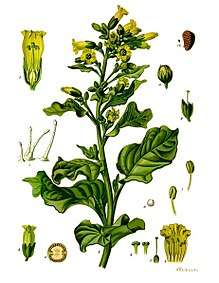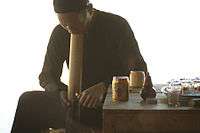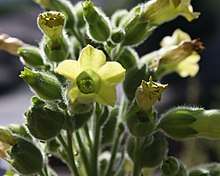Nicotiana rustica
| Nicotiana rustica | |
|---|---|
 | |
| Scientific classification | |
| Kingdom: | Plantae |
| Clade: | Angiosperms |
| Clade: | Eudicots |
| Clade: | Asterids |
| Order: | Solanales |
| Family: | Solanaceae |
| Genus: | Nicotiana |
| Species: | N. rustica |
| Binomial name | |
| Nicotiana rustica | |
Nicotiana rustica, Aztec tobacco[2] or strong tobacco,[3] called ucuch in southern Mexico (specifically Campeche and Yucatán) due to its Mayan roots,[4] mapacho in South America, and thuoc lao (thuốc lào) in Vietnam, is a rainforest plant in the Solanaceae family. It is a very potent variety of tobacco. The high concentration of nicotine in its leaves makes it useful for producing pesticides.
Uses
Nicotiana rustica is often used for entheogenic purposes by South American shamans.[5] It contains up to nine times more nicotine than common species of Nicotiana such as Nicotiana tabacum (common tobacco). Other reasons for its shamanic use are the comparatively high levels of beta-carbolines, including the harmala alkaloids harman and norharman. Most commonly, in South American ethnobotanical preparations, it is allowed to soak or be infused in water, and the water is then insufflated into the stomach in a preparation known as singado or singa; it is also smoked in cigars, used as an enema, made into a lickable product known as ambil, and made into a snuff with the bark of a species of Theobroma, creating nu-nu. In the southeast part of Turkey, people use this herb and ashes of some tree bodies to make a moist snuff called maraş otu. They use this by putting the mixture under their lips like Swedish snus or Afghan naswar. It is also a common admixture of Ayahuasca in some parts of the Amazon.
N. rustica is no longer cultivated in its native North America, as N. tabacum has replaced it.[6] In Russia, N. rustica is called "makhorka" (махорка). Historically, makhorka was smoked mainly by the lower classes. N. rustica is a hardy plant and can be grown in most of Russia (as opposed to N. virginiana which requires a warm climate), it was more readily and cheaply available, and did not depend on transport in a country with an underdeveloped road network and climatic portage problems. This remained the case until ordinary tobacco became widely available in the 20th Century. During Soviet times, rustic tobacco was an important industrial crop of agriculture. In those times, dozens of varieties were bred, some of them considered equal in quality to N. virginiana. In modern times, makhorka is still sometimes smoked by peasants and farmers due to its high availability and being almost for free for them.
N. rustica leaves have a nicotine content as high as 9%, whereas N. tabacum leaves contain about 1 to 3%.[7]
Thuốc lào (in Vietnam)

In Vietnam, it is most commonly smoked after a meal on a full stomach to "aid in digestion", or along with green tea or local beer (most commonly the cheap "bia hơi"). A "hít" of thuốc lào is followed by a flood of nicotine to the bloodstream inducing strong dizziness that lasts several seconds. It should be said, however, that even heavy cigarette smokers have had trouble with the intense volume of smoke and the high nicotine content, and that side effects include nausea and vomiting.
The main difference between smoking thuốc lào and the use of other tobaccos is in the method of consumption, in that thuốc lào is consumed with a water pipe. The smoker is presented with either a bamboo pipe called a điếu cày (English: "farmer's pipe") or a ceramic hookah called a điếu bát. It may also occasionally be smoked in a more uncommon pipe known as a điếu ống. The pipe is filled with an appropriate amount of water and a small amount of thuốc lào is pressed into the bowl.

One then ignites the tobacco and inhales to create a body of smoke inside the pipe, before exhaling the smoke, reversing the process of air in the pipe by blowing into it to pop out the tobacco. The smoker then sharply inhales, usually tilting the pipe upwards to an almost horizontal position (but not completely, as the water would drain out of the mouth).
Maraş otu
Maraş otu (English: Maraş weed) is a chewing variant of Nicotiana rustica. Commonly used by people who live in Maraş. Maraş Otu is a mix of Oak tree ash and Nicotiana rustica that resembles henna.[8] It is recognized as a drug by anti-drug activists.[9] It can contribute to mouth cancers.[10]
References
| Wikimedia Commons has media related to Nicotiana rustica. |
- ↑ "Nicotiana rustica". Germplasm Resources Information Network (GRIN). Agricultural Research Service (ARS), United States Department of Agriculture (USDA). Retrieved 2008-03-17.
- ↑ "Nicotiana rustica". Natural Resources Conservation Service PLANTS Database. USDA. Retrieved 20 July 2015.
- ↑ "BSBI List 2007". Botanical Society of Britain and Ireland. Archived from the original (xls) on 2015-01-25. Retrieved 2014-10-17.
- ↑ Translated by Livio III Ceballos García, all credits go to the quoted website http://www.maya-ethnobotany.org/FLAAR-Reports-Mayan-ethnobotany-Iconography-epigraphy-publications-books-articles-PowerPoint-presentations-course/26_Mayan-ethnobotany-Guatemala-Honduras-El-Salvador-Mexico-Belize-utilitarian-and-sacred-plants-flowers-annual-report-J-2014.pdf
- ↑ "Shamanic Tobaccos". Food of the Gods: The Search for the Original Tree of Knowledge - A Radical History of Plants, Drugs, and Human Evolution. Bantam. 1992. p. 196. ISBN 0-553-37130-4.
- ↑ Ley, Willy (December 1965). "The Healthfull Aromatick Herbe". For Your Information. Galaxy Science Fiction. pp. 88–98.
- ↑ "Nicotiana sp". artsci.wustl.edu. Archived from the original on 2008-09-06. Retrieved 2008-03-17.
- ↑ https://eksisozluk.com/maras-otu--141242?p=3
- ↑ http://www.uyusturucu.info.tr/maras_otu.asp
- ↑ http://www.suluyayla.net/?Syf=26&Syz=11481